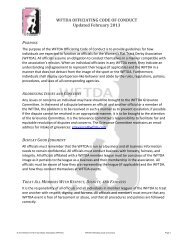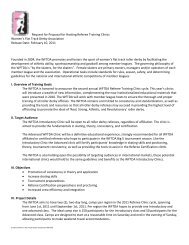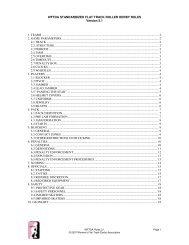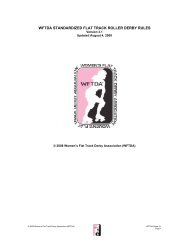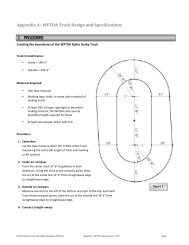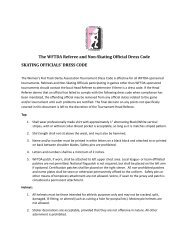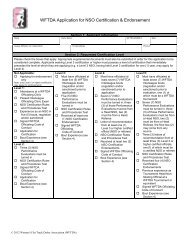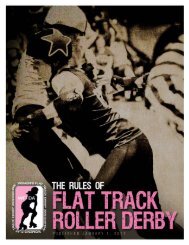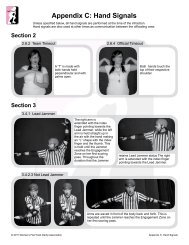WFTDA Officiating Standardized Practices - Women's Flat Track ...
WFTDA Officiating Standardized Practices - Women's Flat Track ...
WFTDA Officiating Standardized Practices - Women's Flat Track ...
Create successful ePaper yourself
Turn your PDF publications into a flip-book with our unique Google optimized e-Paper software.
ISSUE STANDARD PRACTICE<br />
Outside Pack Referee Movement<br />
How should Outside Pack Referees line up and in<br />
what manner should they move to make sure the<br />
pack is covered?<br />
Head Referee Positioning<br />
<strong>WFTDA</strong> OFFICIATING STANDARDIZED PRACTICES<br />
Being uniquely concerned with interleague and tournament practices and ignoring<br />
home needs. Updated January 2013.<br />
Where should the Head Referee be located?<br />
Fluid Half‐Lap OPR: Three skating Outside Pack Referees<br />
provides for the referees to maintain a constant eye on the<br />
pack and consistent coverage.<br />
Basic referee positioning should start at Turn 1, Turn 4, and<br />
in the straightaway between those turns. These positions<br />
can be adjusted based on the starting position of the pack.<br />
Turn‐around areas for Outside Pack Referees are Turns 1‐2<br />
and Turns 3‐4. As the pack starts, the foremost referee will<br />
move forward and use Turns 3‐4 as their first turn‐around<br />
area. The second referee will move forward and use Turns<br />
1‐2 as their first turn‐around area. The rearmost referee<br />
will be considered to be already at their turn‐around area<br />
and will move back to Turn 3 to look at the pack coming<br />
down the straightaway from there.<br />
During the jam, referees reaching a turn‐around area will<br />
go far enough in that turn to see down the outside line of<br />
the upcoming straightaway. As the pack moves away from<br />
them, referees will back up to the start of the turn and<br />
watch the pack come down the previous straightaway.<br />
For example, a referee reaching Turn 4 will complete most<br />
of the turn and watch the pack go down the straightaway<br />
connecting Turns 4 and 1. They will then double back to<br />
Turn 3 and watch the pack approach them in the<br />
straightaway between Turns 2 and 3. The referee then<br />
starts to skate along with the pack, beginning another half<br />
lap towards Turns 1‐2.<br />
The Head Referee will be in position on the inside of the<br />
track. They will position themselves as a front or back<br />
Inside Pack Referee.<br />
© 2013 Women’s <strong>Flat</strong> <strong>Track</strong> Derby Association (<strong>WFTDA</strong>) <strong>WFTDA</strong> <strong>Officiating</strong> <strong>Standardized</strong> <strong>Practices</strong> Page 1
Jammer Referee Designation<br />
How should Jammer Referees designate which<br />
jammer is assigned to a specific referee?<br />
Jammer Penalties<br />
Penalties called on jammers can be decisive. Who is<br />
responsible for calling these penalties?<br />
Jammer Duties and Point Recording<br />
Should the Jammer Referee ever take their eyes off<br />
the jammer to communicate points earned or for<br />
any other reason?<br />
Echoing Calling off the Jam<br />
What should the referees do when the jam is being<br />
called?<br />
Signaling a Skater Off Before the Jam Starts<br />
How should a referee direct a skater off the track<br />
for a penalty before the jam start whistle blows?<br />
Signaling Off the Last Blocker<br />
When a team has only one skater remaining on the<br />
track and that skater commits a penalty, what<br />
should a referee do since, per the rules, a team<br />
must have at least one blocker on the track at all<br />
times?<br />
Jammer Referees will wear color‐coded armbands or<br />
wristbands to designate the teams they are currently<br />
assigned to.<br />
Teams are responsible for maintaining their own<br />
appropriately colored set of bands and providing them for<br />
each bout.<br />
Jammer Referee helmet covers or other team indicators<br />
may be worn, but not to the exclusion of wristbands or<br />
armbands.<br />
Any referee can call major penalties on any skater.<br />
A Jammer Referee should be able to visually check with the<br />
Scorekeeper to verify the score reported. The Scorekeeper<br />
will visually signal back the exact score for the pass that the<br />
Jammer Referee signaled.<br />
This requires that the Scorekeeper maintain the ability to<br />
make eye contact instantaneously, and be signaling the<br />
score received until the referee verifies it.<br />
When calling off the jam, all referees will echo the end‐of‐<br />
jam whistles and hand signals. Jammer Referees should<br />
only use the hand signal if their jammer has called off the<br />
jam.<br />
In order to avoid confusion, a referee will signal the skater<br />
off the track following the standard procedure, but does<br />
not whistle.<br />
The referee calling the penalty should communicate the<br />
penalty to the last blocker as defined by the verbal cues<br />
document, in order to make sure the blocker remains on<br />
the track.<br />
A referee will then signal the skater to the penalty box<br />
when one of their teammates returns to the pack and a<br />
seat in the penalty box is available.<br />
© 2013 Women’s <strong>Flat</strong> <strong>Track</strong> Derby Association (<strong>WFTDA</strong>) <strong>WFTDA</strong> <strong>Officiating</strong> <strong>Standardized</strong> <strong>Practices</strong> Page 2
Expelled or Fouled Out Skater<br />
How shall a Head Referee handle an expelled or<br />
fouled out skater whose penalty box time has<br />
elapsed while the jam is still on?<br />
Hierarchy of Calls<br />
If a skater blocks an opposing skater in the back,<br />
making contact with the forearms, it could be called<br />
as either a forearm block or a back block. How<br />
should a referee ensure that it is not reported twice<br />
or that two separate calls do not get counted as<br />
one?<br />
Inside Whiteboard<br />
ISSUE STANDARD PRACTICE<br />
Skater Identification<br />
How should skater numbers be listed on the inside<br />
whiteboard?<br />
Skater Identification<br />
Are skater names to be included on the inside<br />
whiteboard?<br />
Location<br />
Is there a specific location that the inside<br />
whiteboard should be placed?<br />
Notation<br />
On the inside whiteboard in the center, how should<br />
penalties be marked?<br />
Notation<br />
How should the inside whiteboard denote that a<br />
skater has served their penalty?<br />
The Head Referee shall be the official to inform the skater<br />
that she must leave the track for the remainder of the<br />
game, as delineated in the current rule set.<br />
A hierarchy based on the following penalty categories will<br />
be used:<br />
1. Gross Misconduct / Misconduct<br />
2. Blocking to the Head<br />
3. Position on the <strong>Track</strong> (Out of Play, Out of Bounds,<br />
Direction of Game Play)<br />
4. Illegal Target Zone<br />
5. Illegal Blocking Zone<br />
6. All other non‐contact penalties (such as Cutting,<br />
Skating Out of Bounds, Illegal Procedures,<br />
Insubordination)<br />
Skater numbers on the inside whiteboard should be listed<br />
in an alphabetic sort. The order of characters will start first<br />
0‐9, followed by A‐Z. (Example: 1, 11, 11A, 1A, 2, 21, 2B, 4,<br />
9, A1, etc.)<br />
Numbers are the only skater identification needed on the<br />
inside whiteboard. Names are not needed.<br />
The inside whiteboard should be placed at the center of the<br />
track between the pivot and jammer lines, visible to the<br />
team benches.<br />
Major penalties will be represented by the penalty code for<br />
the infraction (e.g., “X” for cutting, “B” for back block, etc.),<br />
per the codes listed on the penalty tracking sheet.<br />
As each skater sits in the penalty box to serve their penalty,<br />
place a small dot underneath the penalty code to denote<br />
that the skater has served that penalty.<br />
© 2013 Women’s <strong>Flat</strong> <strong>Track</strong> Derby Association (<strong>WFTDA</strong>) <strong>WFTDA</strong> <strong>Officiating</strong> <strong>Standardized</strong> <strong>Practices</strong> Page 3
Notation<br />
Should the inside whiteboard keep track of team<br />
timeouts and/or team official reviews?<br />
Positioning<br />
Where should the Inside Whiteboard Operator be<br />
positioned?<br />
Penalty <strong>Track</strong>ing<br />
ISSUE STANDARD PRACTICE<br />
Number Of Penalty <strong>Track</strong>ers<br />
How many penalty trackers should be used during<br />
bouts?<br />
Skater Number Communication<br />
What should be done if an incorrect or non‐existent<br />
number is reported?<br />
No Penalty for a Skater in the Box<br />
When a skater reports to the box and no penalty<br />
has been reported, what should be done?<br />
Foul Out Warning<br />
How should on‐track skaters with six penalty turns<br />
in the box be handled?<br />
Penalties Issued Between Jams<br />
If a skater incurs a penalty between two jams,<br />
which jam number shall be recorded on the penalty<br />
tracking sheets?<br />
Penalty Issued in Jam, Time Served in Another Jam<br />
If a skater incurs a penalty in one jam, but doesn't<br />
begin serving that penalty until the following jam,<br />
which jam number shall be recorded on the penalty<br />
tracking sheets?<br />
The inside whiteboard shall keep a record of team timeouts<br />
and team official reviews.<br />
The Inside Whiteboard Operator should be positioned<br />
where they can receive penalties from the penalty tracker<br />
to input on the inside whiteboard. They should also assist<br />
the Penalty <strong>Track</strong>er in picking up any penalties that may be<br />
missed.<br />
The officiating crew shall use one Penalty <strong>Track</strong>er and,<br />
optionally, a Penalty Wrangler whose duty will be to help<br />
the Penalty <strong>Track</strong>er.<br />
The Penalty <strong>Track</strong>er or Penalty Wrangler shall check in with<br />
the Head Referee or the appropriate official between jams.<br />
If no penalty has been reported for a skater in the box, the<br />
Penalty <strong>Track</strong>er or penalty wrangler shall check in with the<br />
Head Referee in between jams.<br />
The Penalty <strong>Track</strong>er or Penalty Wrangler shall inform the<br />
Head Referee of any skaters who are at risk of fouling out<br />
due to turns to the box.<br />
The jam number of the jam the skater was participating in<br />
should be used. For example, a late blocker hit would be<br />
recorded in the previous jam, whereas an illegal<br />
engagement while lining up for a jam would be reported in<br />
the next jam.<br />
The jam in which the penalty occurred is the correct jam<br />
number to record on the penalty sheet.<br />
© 2013 Women’s <strong>Flat</strong> <strong>Track</strong> Derby Association (<strong>WFTDA</strong>) <strong>WFTDA</strong> <strong>Officiating</strong> <strong>Standardized</strong> <strong>Practices</strong> Page 4
Penalty Box<br />
ISSUE STANDARD PRACTICE<br />
Clockwise Penalty Box Entry<br />
At what point is a skater considered to be entering<br />
the box from a clockwise direction?<br />
Clockwise Penalty Box Entry<br />
What verbal cue should Penalty Box Officials use to<br />
instruct a skater to skate around?<br />
Communication of Penalty Time Remaining<br />
Besides warning skaters when they have 10 seconds<br />
left, when else should Penalty Timers tell a skater<br />
how much penalty time they have remaining?<br />
Communication from the Penalty Box to Referees<br />
How should the Penalty Box Officials communicate<br />
to the referees that a skater has left the box early,<br />
owes time, or was waved off and now has a seat<br />
available?<br />
Refusal to Stand<br />
What actions should the Penalty Box Official take if<br />
a skater refuses to stand as directed?<br />
Seat Assignment<br />
As a skater is coming into the box, how are they to<br />
know the appropriate seat in which to sit?<br />
So long as the skater is touching the floor within the<br />
boundaries of the furthest forward edge of the penalty box<br />
(the "point of no return"), they should still be considered to<br />
be in the box, and need not skate around to enter the box.<br />
The boundary line is to be considered “in.” While the “point<br />
of no return” line may not physically extend onto the track,<br />
it is considered to extend through the track and, should a<br />
skater pass that line on the track and skate clockwise to<br />
enter the penalty box, they would then be instructed to<br />
skate around.<br />
The Penalty Box Official should use the appropriate verbal<br />
cue: i.e. “Skate around.”<br />
In addition to telling skaters to stand at 10 seconds, and<br />
telling skaters they are done at 0 seconds (using the proper<br />
verbal cues), Penalty Box Officials should update a skater<br />
when they ask how much penalty time is remaining, within<br />
reason.<br />
The penalty box whiteboard is split down the center by<br />
color. When a skater owes time, a Penalty Box Official<br />
displays the skater number on the appropriate side of the<br />
board. If a skater remains in the queue between jams, the<br />
penalty box official should hold up the board to<br />
communicate to the refs which skaters are in the penalty<br />
box queue. If the skater was not released by a penalty box<br />
official, the number shall be circled. Upon seeing this, a<br />
referee sends the skater in question back to the penalty<br />
box. If the number is circled, the referee sees that the<br />
skater is not in the penalty box and assigns the appropriate<br />
penalty for early departure from the penalty box.<br />
The Penalty Box Official shall inform the skater who is<br />
refusing to stand that the remaining penalty time will not<br />
be timed until they stand.<br />
A Penalty Box Official shall signal the appropriate side<br />
and/or seat as the skater skates into the box.<br />
© 2013 Women’s <strong>Flat</strong> <strong>Track</strong> Derby Association (<strong>WFTDA</strong>) <strong>WFTDA</strong> <strong>Officiating</strong> <strong>Standardized</strong> <strong>Practices</strong> Page 5
Penalty Box Seat Limit<br />
What should Penalty Box Officials do when a skater<br />
arrives at the penalty box, but there is no seat<br />
available for them?<br />
Further Penalty Box <strong>Practices</strong><br />
Are there any further practices a penalty box official<br />
should respect?<br />
Jam Timer<br />
ISSUE STANDARD PRACTICE<br />
Jam Timer Location<br />
Where should the Jam Timer be located?<br />
Beginning of the Jam<br />
Should the Jam Timer make some sort of signal<br />
before the start of the jam? Are there any signals<br />
that the Jam Timer should use at the jam start<br />
whistle?<br />
Official Timeouts<br />
If the 30 seconds between jams are about to expire<br />
and the officials are not in position, what should the<br />
jam timer do?<br />
Official Timeouts<br />
If a referee signals for an official timeout, what<br />
should the Jam Timer do?<br />
A penalty box official shall signal to the skater that the<br />
penalty box is full with the hand signal and verbal cue, i.e.<br />
“Return to the track,” with appropriate signal. See the<br />
hand signal document for a description of these signals<br />
and their appropriate usage.<br />
Penalty Box Officials should not sit or stand in any location<br />
in which they may be confused with a skater serving a<br />
penalty.<br />
If not timing a penalty for any reason (skater is not sitting,<br />
skater entered the penalty box from the wrong direction),<br />
the Penalty Box Official should inform the skater.<br />
The Jam Timer is stationed on the inside of the track where<br />
they can be seen and heard by both the pack and the<br />
jammers, without being in any referee’s way.<br />
Five seconds before the beginning of the jam, the Jam<br />
Timer shall raise their open hand in the air with all five<br />
fingers visible while using the appropriate verbal cue. Once<br />
the jam start whistle is blown, the Jam Timer will point to<br />
the pivot line until all skaters seemingly understand that<br />
the jam has begun.<br />
If the 30 seconds are about to expire without the officials in<br />
position, the jam timer is empowered to call an official<br />
timeout.<br />
The Jam Timer should immediately signal four short whistle<br />
blasts, stop the period clock, and get in position in front of<br />
the pivot line.<br />
© 2013 Women’s <strong>Flat</strong> <strong>Track</strong> Derby Association (<strong>WFTDA</strong>) <strong>WFTDA</strong> <strong>Officiating</strong> <strong>Standardized</strong> <strong>Practices</strong> Page 6
Timeout Procedures<br />
What is the procedure for a timeout from the<br />
moment a Captain or their Designated Alternate<br />
signals it to the moment it is displayed on the<br />
scoreboard?<br />
End of Timeout<br />
How should the “End of Timeout” whistle sound?<br />
End of Jam<br />
How should the jam timer signal the end of a jam?<br />
Scorekeeping and Scoreboard<br />
ISSUE STANDARD PRACTICE<br />
Point Reporting<br />
Shall Scorekeepers echo back the number of points<br />
being reported by their Jammer Referee?<br />
Scoreboard Updates<br />
How often should the official running the<br />
scoreboard update the score?<br />
Head Non-Skating Official<br />
ISSUE STANDARD PRACTICE<br />
Head Non‐Skating Official<br />
Should there be a Head Non‐Skating Official (Head<br />
NSO)?<br />
Non‐Skating Official Paperwork<br />
Who handles the non‐skating official paperwork?<br />
The Captain or their Designated Alternate signal the<br />
timeout. After confirming that the team has a timeout<br />
remaining, the Jam Timer or the first referee to see the<br />
signal calls the timeout by sounding four short whistle<br />
blasts. The Jam Timer stops their stopwatch and signals to<br />
the Scoreboard Operator that a timeout has occurred. The<br />
Jam Timer should indicate if the timeout is a team timeout<br />
or an official timeout by using the corresponding hand<br />
signal. The Jam Timer should correct the visible game clock<br />
as needed during the timeout.<br />
The whistle shall be one rolling/swooping whistle blast.<br />
Once two minutes have elapsed, the jam timer should<br />
sound four short whistle blasts and use the corresponding<br />
hand signal for the end of the jam, i.e. tapping the hips<br />
multiple times per the Jammer call off signal.<br />
If the jam is called off for any other reason, the jam timer<br />
should still echo the referee whistles, but the hand signal<br />
will not be used.<br />
The Scorekeeper shall make a physical signal for each<br />
pass.<br />
The score on the scoreboard shall be updated for each<br />
pass, as per the score from the scorekeeper.<br />
A person should be appointed as the Head NSO. This<br />
person will oversee the non‐skating official crew and<br />
ensure its proper performance.<br />
The Head NSO will ensure that the NSO paperwork has<br />
been properly populated prior to the game. The head NSO<br />
will oversee the distribution and retrieval of the<br />
paperwork before and after the game.<br />
© 2013 Women’s <strong>Flat</strong> <strong>Track</strong> Derby Association (<strong>WFTDA</strong>) <strong>WFTDA</strong> <strong>Officiating</strong> <strong>Standardized</strong> <strong>Practices</strong> Page 7



